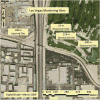Factors associated with NO2 and NOX concentration gradients near a highway
- PMID: 29456452
- PMCID: PMC5812691
- DOI: 10.1016/j.atmosenv.2017.11.026
Factors associated with NO2 and NOX concentration gradients near a highway
Abstract
The objective of this research is to learn how the near-road gradient, in which NO2 and NOX (NO + NO2) concentrations are elevated, varies with changes in meteorological and traffic variables. Measurements of NO2 and NOX were obtained east of I-15 in Las Vegas and fit to functions whose slopes (dCNO2 /dx and dCNOX /dx, respectively) characterize the size of the near-road zone where NO2 and NOX concentrations from mobile sources on the highway are elevated. These metrics were used to learn about the near-road gradient by modeling dCNO2 /dx and dCNOX /dx as functions of meteorological variables (e.g., wind direction, wind speed), traffic (vehicle count), NOX concentration upwind of the road, and O3 concentration at two fixed-site ambient monitors. Generalized additive models (GAM) were used to model dCNO2 /dx and dCNOX /dx versus the independent variables because they allowed for nonlinearity of the variables being compared. When data from all wind directions were included in the analysis, variability in O3 concentration comprised the largest proportion of variability in dCNO2 /dx, followed by variability in wind direction. In a second analysis constrained to winds from the west, variability in O3 concentration remained the largest contributor to variability in dCNO2 /dx, but the relative contribution of variability in wind speed to variability in dCNO2 /dx increased relative to its contribution for the all-wind analysis. When data from all wind directions were analyzed, variability in wind direction was by far the largest contributor to variability in dCNOX /dx, with smaller contributions from hour of day and upwind NOX concentration. When only winds from the west were analyzed, variability in upwind NOX concentration, wind speed, hour of day, and traffic count all were associated with variability in dCNOX /dx. Increases in O3 concentration were associated with increased magnitude near-road dCNO2 /dx, possibly shrinking the zone of elevated concentrations occurring near roads. Wind direction parallel to the highway was also related to an increased magnitude of both dCNO2 /dx and dCNOX /dx, again likely shrinking the zone of elevated concentrations occurring near roads. Wind direction perpendicular to the road decreased the magnitude of dCNO2 /dx and dCNOX /dx and likely contributed to growth of the zone of elevated concentrations occurring near roads. Thus, variability in near-road concentrations is influenced by local meteorology and ambient O3 concentration.
Keywords: Dispersion; NO2; Near-road; Nitrogen dioxide; Oxides of nitrogen.
Figures






References
-
- Atkinson R. Atmospheric chemistry of VOCs and NOX. Atmos. Environ. 2000;34:2063–2101.
-
- Baldauf R, Thoma E, Hays M, Shores R, Kinsey J, Gullett B, et al. Traffic and meteorological impacts on near-road air quality: summary of methods and trends from the Raleigh Near-road Study. J. Air Waste Manag. Assoc. 2008;58:865–878. - PubMed
-
- Baldauf R, Watkins N, Heist D, Bailey C, Rowley P, Shores R. Near-road air quality monitoring: factors affecting network design and interpretation of data. Air Qual. Atmos. Health. 2009;2:1–9.
-
- Baldwin N, Gilani O, Raja S, Batterman S, Ganguly R, Hopke P, et al. Factors affecting pollutant concentrations in the near-road environment. Atmos. Environ. 2015;115:223–235.
-
- Bloomfield P, Royle JA, Steinberg LJ, Yang Q. Accounting for meteorological effects in measuring urban ozone levels and trends. Atmos. Environ. 1996;30:3067–3077.
Grants and funding
LinkOut - more resources
Full Text Sources
Other Literature Sources
